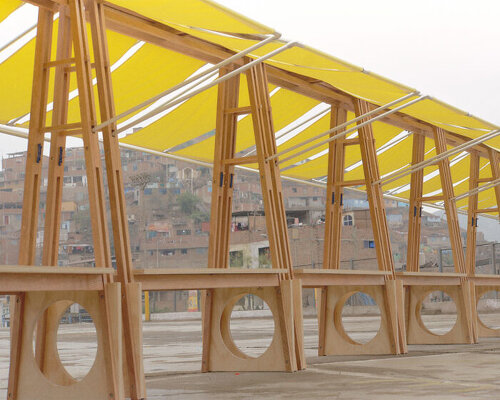OUTSTANDING PROJECTS THAT GENERATE SHADE IN PUBLIC SPACES
As climate change makes hot summers more intense – especially in dense cities – the need for intentional, well-designed shade in public spaces becomes more and more critical. Architects and urban designers have a rich toolkit at their disposal, drawing on both time-tested traditions and cutting-edge innovation to create shaded oases in the urban fabric. Highlighting a diverse spectrum of approaches, we dive into solutions, ranging from monumental structures to intimate, human-scale interventions.
From reinterpreted architectural archetypes to ephemeral urban gestures, today’s shade-making strategies fall into a number of recognizable yet evolving categories. Among the oldest and most enduring is the colonnade — a classical solution that offers both structural clarity and solar protection. These columned corridors have long defined civic space, guiding rhythmic movement while casting shadows that cool and animate the surroundings. Lighter in presence but equally time-honored, pergolas create a more permeable kind of shelter, filtering sunlight through latticed framework and often inviting climbing plants to deepen the shade. Expanding on the gesture, canopies introduce bold overhead surfaces — projecting from buildings or standing alone — to create shaded zones for gathering, pausing, or passing through. Unlike pergolas, their shade is often generated entirely by their own form and material, making them powerful sculptural statements. However, not all shade needs to be monumental. Thoughtfully designed street furniture can incorporate shading elements to provide comfort at a human scale, enhancing the daily experience of pedestrians and sometimes, the line between a functional shade structure and a piece of public art is completely blurred. Some installations use form, material, and color to create a unique aesthetic while simultaneously providing welcome shade.
GARDENS BY THE BAY BY GRANT ASSOCIATES AND WILKINSON EYRE
Supertree Grove at Gardens by the Bay, Singapore | image © Gardens by the Bay
The Supertrees at Singapore’s Gardens by the Bay are a futuristic take on the traditional pergola. Conceived by Grant Associates with engineering from Atelier One and Atelier Ten, these 18 structures stand between 25 and 50 meters tall. Beyond their dramatic appearance, they are vertical gardens with a multitude of functions. Their robust steel frames support a diverse array of climbing plants, which form a vibrant, living sunshade for the ground level.
EMERALD SCREEN PERGOLA BY WUTOPIA LAB
Emerald Screen Pergola at Bogong Island Ecology Park in Wuxi, China | image © CreatAR
This modern pergola by Wutopia Lab reimagines classical Chinese garden architecture into a white steel mesh corridor, spanning over a kilometer. Described by the architects as a ‘wandering dragon-like’ form, its intricate design creates a dynamic interplay of light and shadow, and serves as a significant symbol in Chinese art and culture. The design’s final stage will see climbing plants like wisteria and jasmine ascend the framework, transforming the pergola into a lush, vibrant green sunshade.
JAMES-SIMON-GALLERY BY DAVID CHIPPERFLIED
the James-Simon-Gallery and its modern colonnade extend the historic forum, Berlin | image © David Chipperfield Architects
As the new entrance building for Berlin’s museum island, the James-Simon-Galerie by David Chipperfield features a grand, modern colonnade. The design serves as a continuation of the forum architecture originally envisioned for the site, using a rhythmic sequence of slender, elegant columns to create a vast, shaded promenade. This not only provides a sheltered route to the Pergamonmuseum and Neues Museum but also carves out a key public space that protects visitors from the sun, forming an integral part of the masterplan to transform the UNESCO World Heritage Site.
BOSQUE DE LA ESPERANZA BY GIANCARLO MAZZANTI
Bosque de la Esperanza by Giancarlo Mazzanti, Colombia | image © Jorge Gamboa
Bosque de la Esperanza by Giancarlo Mazzanti is a standalone canopy structure that serves as a public plaza and sports court in the town of Altos de Cazuca, Colombia. Its 700 m² canopy is comprised of prefabricated dodecahedrons wrapped in a light and porous expanded steel mesh, which provides shading while mimicking a cluster of trees. The project’s primary purpose is to create a vast, continuous shaded space and a community meeting point, with integrated lighting that allows it to act as a glowing public forum at night, transforming a previously neglected area.
HIYOSHI RIBBON TERRACE BY JORGE ALMAZÁN AND KEIO UNIVERSITY STUDIOLAB
Keio University’s campus in Yokohama, Japan | image © Jorge Almazán and Keio University StudioLab
On Keio University’s campus in Yokohama, Japan, the amphitheater was transformed by a dynamic, temporary canopy. Designed by Jorge Almazán and Keio University StudioLab, the Hiyoshi Ribbon Terrace features a playful, maypole-like arrangement of bright orange fabric panels. Suspended from the adjacent building, the ribbons provide essential shade while allowing for a pleasant balance of airflow and natural light. This flexible structure has successfully breathed new life into the concrete courtyard, creating a comfortable and vibrant outdoor space for students to gather and interact.
FLOWER INSTALLATION BY SNØHETTA
petal-shaped canopy by Snøhetta, Texas | image © by Sloan Breeden Photography
At the Blanton Museum of Art in Austin, Texas, Snøhetta completed a transformation that included a new canopy of sculptural, petal-shaped structures. Standing 40 feet tall, these perforated panels are arranged in a series of 12 flower-like forms, providing functional shade and a playful pattern of dappled light over the museum’s Moody Patio. The installation, inspired by the museum’s arched vaults, also serves a practical purpose by collecting and filtering rainwater to nourish native plantings, proving that artistic design can be integrated to a building’s ecosystem.
SEASIDE PAVILION BY GN ARCHITECTS
Seaside Pavilion by GN Architects on Chaishan Island, Taiwan | image © Liang Wenjun
The Seaside Pavilion by GN Architects on Chaishan Island, Taiwan, is a poetic installation that symbolizes the region’s renewal. As the winning design from the ‘Hello, Island’ competition, the pavilion’s striking roof structure is made of 36 seven-meter-long white, feather-like blades. The design, inspired by a traditional village entrance, allows wind to pass through while providing effective shade and creating a cool, breezy rest area for the island’s elderly residents. Computer-simulated and engineered to sway gently with the sea breeze, the pavilion repurposes an old pier into a practical and symbolic gathering space.
SOBREMESAS BY SALAZARSEQUEROMEDINA + BIAU
Sobremesas by salazarsequeromedina, Peru | image © by Ivan Salinero
Sobremesas is a modular street furniture system designed for communal gatherings and shared meals, with a built-in canopy structure that creates a shaded, outdoor forum for social interaction. Developed by salazarsequeromedina, the project was a key part of the Ibero-American Biennial of Architecture and Urbanism (BIAU) in Lima, Peru. Constructed from locally sourced Tornillo wood, its modular design allows for flexible configurations to support a variety of community activities, from markets to educational workshops. Following the event, the system was donated to local community kitchens, embodying its core purpose of strengthening local networks and fostering community resilience beyond its initial installation.
THE SCAPE FOR EVERY MOMENT BY ICAI ARCHITECTS
Scape for Every Moment street furniture installation, Japan | image © Munetaka Onodera
In a small park cornered by skyscrapers in Yokohama, Japan, icai architects introduced the Scape for Every Moment street furniture installation. The project uses delicate organdie curtains to create a dynamic, poetic shading element that brings soft, flowing movement to a rigid urban landscape. The curtains’ appearance constantly changes with the natural elements of light and wind, casting shifting shadows and glowing with reflections from the surrounding high-rises. This temporary yet sturdy installation offers a unique, ever-changing shelter that encourages community interaction and fosters a connection with nature amidst a bustling city.
CIRCLE AND SQUARE BY BEHIN HA
Circle and Square, temporary public art installation, China | image © StudioSZ Photo / Justin Szeremeta
Circle and Square is a temporary public art installation that creates a vibrant, shaded environment within a mixed-use development in Hangzhou, China. Designed by Behin Ha, the project uses 426 bright orange mesh fabric ribbons stretched between the building’s roofline and the ground. The ribbons are anchored in circular arrays to shape two distinct outdoor spaces. Casting a warm, dappled light on the ground, the installation invited passersbys to engage with the artwork, providing a functional and temporary addition to the public realm.
The post better than sunscreen: solar protection through intentional shade in public spaces appeared first on designboom | architecture & design magazine.

